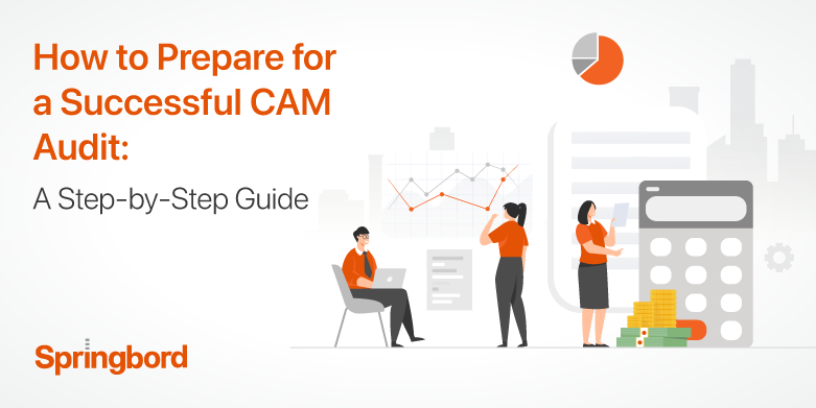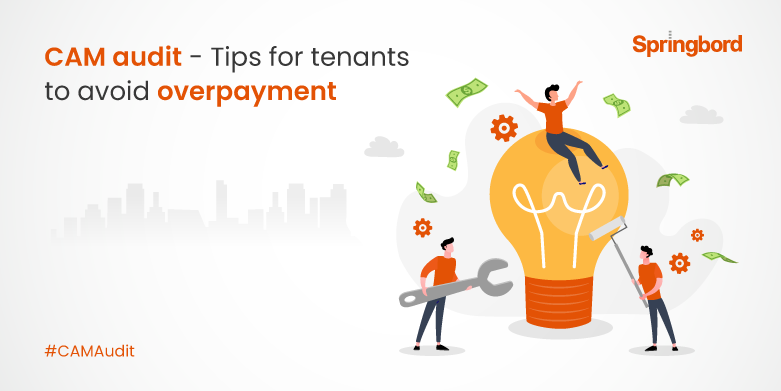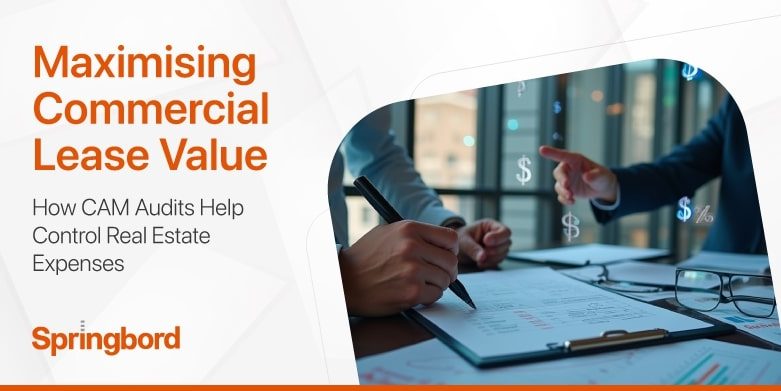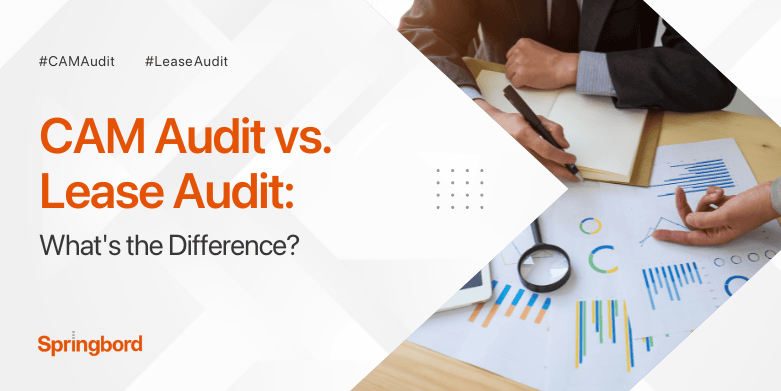 Read time 6 min
Read time 6 minCommon Area Maintenance (CAM) audits are critical for landlords and tenants to ensure fair cost allocation and transparency in financial dealings. However, preparing for a CAM audit can be daunting, requiring meticulous attention to detail and a comprehensive understanding of lease agreements and operating expenses.
In this advanced guide, we’ll delve into the intricacies of CAM audits, offering seasoned business owners strategic insights and practical steps to navigate this process with confidence and success. At Springbord, we understand business owners’ challenges in preparing for CAM audits, and we’re committed to providing comprehensive solutions tailored to your needs.
Understanding CAM Audits
In commercial real estate management, ensuring fair allocation of common area expenses is paramount for maintaining landlord-tenant relationships and financial transparency. CAM audits play a pivotal role in achieving this goal, serving as a mechanism to scrutinize and reconcile expenses related to shared spaces within commercial properties.
Definition and Purpose:
CAM audits refer to the examination of common area expenses incurred by landlords, which are then allocated among tenants as per lease agreements. These audits serve the fundamental purpose of ensuring equitable distribution of costs associated with maintaining shared areas such as lobbies, hallways, parking lots, and landscaping. By scrutinizing expenses and reconciling them with lease provisions, CAM audits promote transparency and fairness in commercial lease agreements.
Legal Framework:
The legal landscape surrounding CAM audits is multifaceted, encompassing lease provisions, industry standards, and regulatory requirements.
- Lease agreements typically outline the obligations of landlords and tenants regarding CAM expenses, including the scope of common areas and methods of cost allocation.
- Moreover, industry standards and best practices provide guidance on conducting CAM audits effectively, ensuring compliance with legal and ethical norms.
- Relevant regulations, such as local property laws and accounting standards, further shape the legal framework governing CAM audits, necessitating meticulous adherence to statutory requirements.
Key Stakeholders:
CAM audits involve various stakeholders, each playing distinct roles in the audit process.
- Landlords are responsible for maintaining accurate records of common area expenses and facilitating the audit process in accordance with lease agreements.
- Tenants, on the other hand, have the right to review and challenge CAM expenses to ensure they are reasonable and properly allocated.
- Auditors, whether internal or external, are tasked with conducting thorough examinations of financial records and verifying compliance with lease provisions.
- Legal counsel may also be involved to provide guidance on contractual obligations and resolve disputes arising from CAM audits.
1. Pre-Audit Preparation
As business owners involved in commercial real estate, preparing for a Common Area Maintenance (CAM) audit demands meticulous planning and attention to detail. This crucial step sets the foundation for a smooth and successful audit process, ensuring that both landlords and tenants are equipped to navigate the complexities of CAM expenses and allocations.
Review Lease Agreements:
Conducting a thorough review of lease agreements is crucial, as discrepancies often lead to disputes. By carefully analyzing CAM provisions and tenant responsibilities, businesses can proactively address potential areas of contention and minimize audit-related disputes.
Organize Documentation:
Compiling and organizing relevant financial records, invoices, receipts, and lease documents is essential for streamlining the audit process. Therefore, implementing robust document management systems can significantly enhance efficiency and reduce audit preparation time.
Engage Experts:
Consideration of expert support, such as experienced CAM auditors or legal professionals specializing in commercial real estate, can provide invaluable guidance and support throughout the audit process. Imposing the expertise of professionals, businesses can direct complex CAM audit requirements with confidence, ensuring compliance with lease agreements and regulatory standards.
At Springbord, our team of seasoned professionals offers unparalleled support in CAM audit preparation, empowering clients to achieve optimal outcomes and maximize cost savings.
2. Audit Strategy Development
Developing a robust audit strategy is crucial for ensuring transparency and accuracy in CAM expenses.
Establish Audit Objectives:
Defining clear objectives is the foundation of a successful CAM audit strategy. By setting specific goals, such as uncovering billing errors or optimizing expense allocations, businesses can focus their audit efforts and maximize outcomes.
At Springbord, we work closely with clients to articulate their audit objectives and tailor strategies accordingly, ensuring alignment with business priorities and regulatory requirements.
Conduct Preliminary Analysis:
Conducting a preliminary analysis is essential for identifying areas of concern and optimization opportunities. By analyzing historical data, budget projections, and industry benchmarks, businesses can pinpoint potential discrepancies and trends, informing targeted audit procedures.
At Springbord, we leverage advanced analytics and industry expertise to conduct comprehensive preliminary analyses, enabling clients to make informed decisions and optimize audit outcomes.
Develop Audit Procedures:
Developing a detailed audit plan is crucial for guiding the audit process effectively. The audit plan should outline procedures, timelines, and methodologies for reviewing expenses and reconciling discrepancies.
At Springbord, our experienced professionals collaborate with clients to develop tailored audit procedures, leveraging cutting-edge technologies and best practices to streamline the audit process and ensure accuracy.
3. Conducting the Audit
As businesses delve into CAM audits, the process of conducting the audit itself demands precision and attention to detail.
On-Site Inspection:
A critical aspect of the CAM audit is the on-site inspection of common areas. During these inspections, it’s essential to meticulously evaluate the condition of common areas, identify any capital improvements, and verify that expenses align with lease agreements and industry standards.
At Springbord, our experienced professionals conduct thorough on-site inspections, leveraging their expertise to ensure accuracy and compliance with audit objectives.
Scrutinize Financial Records:
Reviewing financial records is another crucial step in the CAM audit process. During this phase, it’s imperative to review invoices, receipts, and accounting records to verify accuracy and consistency with lease agreements and industry standards.
At Springbord, we employ advanced analytical tools and methodologies to conduct comprehensive reviews of financial records, identifying potential discrepancies and ensuring compliance with audit requirements.
Communicate with Stakeholders:
Maintaining open communication with stakeholders is essential for addressing any issues or concerns that may arise during the audit process. Regular communication with landlords, tenants, and auditors fosters transparency and collaboration, facilitating timely resolution of disputes and ensuring alignment with audit objectives.
At Springbord, we prioritize clear and transparent communication with stakeholders, enabling clients to navigate CAM audits with confidence and efficiency.
4. Resolving Disputes and Negotiating Settlements
Disputes arising from CAM audits are inevitable in commercial real estate, but effectively resolving them is essential for maintaining positive landlord-tenant relationships and financial transparency. Through the following steps, businesses can navigate disputes with confidence and protect their interests.
Identify Discrepancies:
During CAM audits, documenting discrepancies is crucial, as unresolved issues can lead to strained relationships and financial losses. By engaging in constructive dialogue with stakeholders and documenting discrepancies transparently, businesses can lay the groundwork for amicable resolution and mitigate potential disputes.
At Springbord, we emphasize thorough documentation and proactive communication to facilitate effective dispute resolution.
Negotiation Strategies:
Employing effective negotiation tactics is essential for reaching fair and equitable settlements on disputed CAM expenses. By grasping industry benchmarks and best practices, businesses can strengthen their negotiation position and achieve favourable outcomes.
Our experts at Springbord, specialize in negotiation techniques tailored to CAM audit disputes, ensuring clients achieve optimal settlements while preserving positive relationships.
Legal Recourse:
In cases where disputes remain unresolved or lease agreements are violated, exploring legal recourse may be necessary to protect business interests. Whether through mediation, arbitration, or litigation, legal avenues provide mechanisms for resolving disputes impartially and enforcing contractual obligations.
Springboard’s comprehensive support in planning legal processes, empowers clients to protect their interests and achieve just resolutions.
5. Post-Audit Follow-Up
Completing a CAM audit marks a significant milestone, but the true value lies in the post-audit follow-up activities.
Document Findings:
Preparing a comprehensive audit report is essential for capturing key findings, recommendations, and resolutions reached during the audit process. Businesses can provide stakeholders with transparent insights into audit outcomes and facilitate informed decision-making.
Springbord specializes in crafting detailed audit reports that serve as valuable reference tools for stakeholders, ensuring clarity and accountability.
Implement Best Practices:
Incorporating lessons learned from the audit into future lease negotiations, expense management strategies, and dispute resolution processes is critical for continuous improvement. Using insights gained from the audit, businesses can optimize lease agreements and enhance dispute resolution capabilities.
At Springbord, we collaborate with clients to identify and implement best practices tailored to their unique needs, driving efficiency and effectiveness across their operations.
Monitor Compliance:
Establishing mechanisms for ongoing monitoring and review of CAM expenses is essential for maintaining compliance with lease agreements and preventing future disputes. Businesses can identify potential discrepancies early on and take corrective action to mitigate risks.
Springbord offers comprehensive solutions for monitoring compliance, leveraging advanced technologies and best practices to ensure ongoing adherence to lease agreements and regulatory standards.
Conclusion
Successfully navigating a CAM audit requires meticulous preparation, strategic execution, and proactive follow-up. By adhering to the step-by-step guide outlined in this advanced resource, business owners can confidently tackle CAM audits, ensuring fairness, transparency, and compliance with lease agreements.
Springbord specializes in commercial real estate management and financial analysis, offering tailored solutions to meet your needs. Whether you’re gearing up for a CAM audit or require assistance with post-audit follow-up, our expert team is here to support you every step of the way.
Contact Springbord today to maximize the value of your commercial real estate investments.







